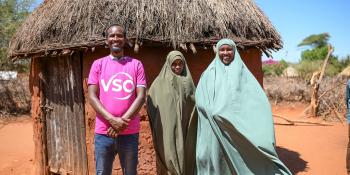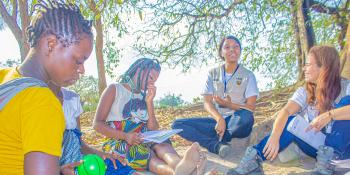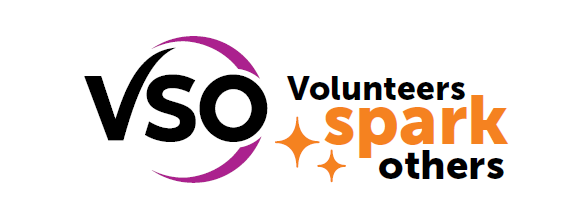After the coronavirus pandemic sparked a nationwide lockdown in Myanmar, we look at how VSO has been supporting students in Myanmar, whether they are in school or at home.
On 1 May, Myanmar went into lockdown, with all schools closed and restrictions placed on movement. Here, a quarter of all people lived below the poverty line as of 2017. Many children don’t have the all-important textbooks necessary for study, and culturally there is an expectation for children to help around the home. For many children, this has been a time when education stood still.
It's so important to support these communities because very little is understood about the virus in rural areas of Myanmar, and we know that endless hours at home puts children at greater risk.
“People here in Mon state do not understand coronavirus - especially those from very isolated areas who already have a limited understanding and awareness of health,” said Mi Mon Sorn, a headteacher of a school in the region.
In the past few months, children like 13-year-old Mi Hlaing* have been expected to do household chores rather than study.
“I love wearing a school uniform, I wish could wear one again,” says Mi Hlaing. “I want to back to be in school. I lost touch with my friends and am not able to carry on learning at school.
“Hopefully I can return to school or else my whole life will just be doing domestic chores.”
At the beginning of July, with COVID-19 cases greatly reduced, children in Mon state, in the south of Myanmar, started to return to school.
“When the school reopened, some of the students were already waiting in front of the school before the teachers got there. The students were very excited to be back,” says teacher Mi Ar Jae Noor.
“I was surprised and happy to be back in school,” says fifteen-year-old Min Zaw*. “While the school was closed I had to grow betel nut (the seed of a berry used as a stimulant drug, similar to chewing tobacco) and lemon seed on my family’s farm and did not have much opportunity to study.
“There is a big difference between going to school in the past and now. We have to sit separately from each other. And the school is no longer the same as it used to be. The school day is shorter now, I just come in for the morning and am back home at noon.”
In addition to social distancing measures, VSO volunteers from Myanmar distributed 10,000 back-to-school kits of facemasks, visors and soap and milk.
Headteacher Mi Mon Sorn acknowledges the inherent challenges of returning to school:
“I was a little scared of reopening the school at first. I was worried about the risk of infection to my students because children will be children. No matter what, they won’t be as concerned as adults.”
Now, the school day looks very different. It used to start with the pupils standing in a big group assembly singing the Burmese national anthem. This daily ritual is now replaced with washing hands.
“The students have started to understand how to stay safe at school like how to wash their hands and how to prevent the virus from spreading,” says teacher Mi Ar Jae Noor.
VSO has spread awareness of COVID-19 with posters and pamphlets, like the one seen in the picture above, translated into local languages and shared to schools and surrounding communities before schools reopened. Teachers worked with VSO volunteers to assemble parents to explain adjustments that would be made in the school to reduce the spread of COVID-19.
“I am happy to be in school again,” says Mi Htun*. “I thought about school a lot when the school was closed. I did not study at home because I had to help my parents. Now, I have to wear a mask and face shield to go to school.”
Headteacher Mi Mon Sorn was keen to reopen the school, knowing exactly was at stake for the students.
“We know if the school is shut for a long time, the children’s education will be severely disrupted. Some children will get married at an early age and for male students, if they stay at home for long periods, they may experiment with drugs. It’s one of the biggest emerging issues here in Mon state.”
“When children are in school, teachers can easily communicate with parents, sharing how their child is doing, their attitude and their development. They are able to study more, and get a sense of belonging from being at school.”
Desks are now spaced out, children wash their hands frequently and to reduce classroom sizes, the school day is run across two shifts: one in the morning, one in the evening.
Twelve-year-old Min Htay* said, “I was very happy to be back in school. I missed the teachers and playing with my friends at school.”
Many children, like nine-year-old Mi Khine*, found it challenging to study at home.
“I missed school so much when it was shut. I am not comfortable being at home and studying alone. My mother wanted me to drop out of school this year, but with the assistance from the school, she changed her mind and I am still going to school.”
Volunteers are working with school leadership teams to make sure children come back to school – at this Mon state school, all students successfully returned at the beginning of July, following the efforts of volunteers and teachers.
The safe reopening of schools was made possible by volunteers like Hnin Hnin Wai, 26, a community volunteer who joined VSO in the midst of the COVID-19 response. She has run sessions with teachers on how to reduce the spread of coronavirus in classrooms. Having a volunteer like Hnin helps to lessen the heavy burden placed on teachers at this time.
“Due to the pandemic, teachers have more responsibilities like looking after students, checking to make sure they are practising social distancing, and are taking on more teaching shifts. They also have to check health guidelines and share information with students,” says Hnin Hnin.
After an increase in coronavirus cases across the country, schools closed at the end of August. While children in Mon state eagerly await schools reopening for good, many are doing their best to learn from home.
Volunteers have distributed 1,200 at-home education kits of storybooks, exercise books, pencils, a sharpener and eraser. The story books included in the home education kits are written in the local Mon language and the stories promote messages of peace, diversity and tolerance.
Volunteers are also advising teachers on how to keep children learning even while at home, with 27 teachers trained so far in how to run lessons over the web. And, when schools do go back, they are ready to do so safely.
Whether schools are open or not, VSO volunteers like Hnin Hnin and the dedicated teachers in Mon state will be there to support children so they can still learn and grow.
“VSO is making a better world for those in poverty and giving hope to vulnerable children that they, too, can pursue their dreams,” says Hnin Hnin. “Children are our future because they will be the leaders of our communities and countries. The changes we make today are not only for today.”
(*Names have been changed to protect children's identities.)
Find out more about our work in inclusive education
We're adapting our education programming to keep children safe and learning – both throughout periods of lockdown, and as they return to school.
Read more

A ripple of change: how VSO volunteers are transforming communities
Every act of volunteering begins with a choice — a decision to act out of a desire to make a difference. Across the world, VSO volunteers are proving that one spark of action can ignite something much bigger.

The two volunteers empowering girls and young women in Mozambique
Nelma and Carmirene and are two volunteers working on VSO's EAGLE project in Mozambique. For Nelma and Carmirene, education is not just about school, it is about meeting people where they are and using the right tools to challenging harmful norms. Here are their stories.
Opening doors to safety, education, and a brighter future
For girls in Karamoja, the poorest region in Uganda, being forced into early motherhood is all too common. This Christmas, you can open the doors to Safety, Education, and a Brighter Future.
